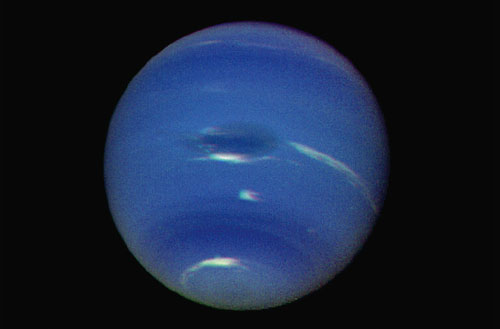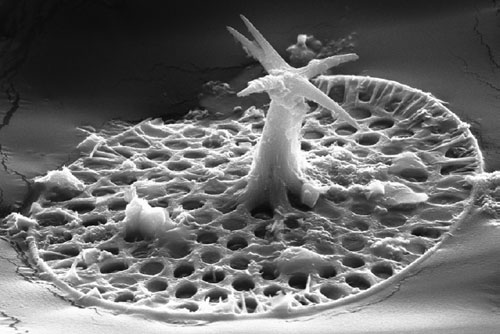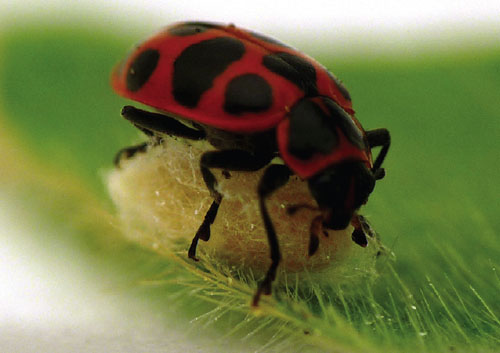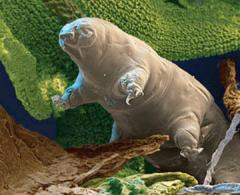
This Article From Issue
September-October 2011
Volume 99, Number 5
Page 383
DOI: 10.1511/2011.92.383
In this roundup, Elsa Youngsteadt summarizes some notable recent items about scientific research, selected from news reports compiled in Sigma Xi’s free electronic newsletters.
A Day Defined
Neptune’s thick, blue atmosphere obscures any solid landmarks, making the planet’s rotation tough to track. But after scrutinizing hundreds of images from the Voyager 2 spacecraft and the Hubble telescope, an astronomer says he’s done it: The ice giant rotates once every 15 hours, 57 minutes and 59 seconds. That’s eight and a half minutes faster than the previous best estimate. The new analysis depends on two stable cloud patterns that, during 20 years of observation, never blew away with prevailing winds. Their constancy suggests these disturbances are linked to stable features deeper inside the planet and reveal its underlying spin. The new day length could spur other discoveries. Neptune’s core density, for example, may be recalculated to account for the faster rotation. (Image courtesy of NASA.)

Image courtesy of NASA.
Karkoschka, E. Neptune’s rotational period suggested by the extraordinary stability of two features. Icarus (published online May 20)
Early Armor
Crunchy organisms with mineralized bones and shells link the worlds of biology and geology. That link first formed at least 750 million years ago, according to a study of the oldest direct evidence for biomineralization. The evidence takes the form of lacy, spine-fringed fossils such as that of the Characodictyon alga pictured above at right. Just a few hundredths of a millimeter long, these relics were preserved in outcrops in Canada’s Yukon Territory. Spectroscopy and microscopy suggest that the minute shells mineralized while the cells were still alive, rather than during fossilization: All were composed of phosphate minerals, regardless of the kind of rock in which they were embedded. And their structures were consistent from one individual to the next, not distorted like those of softer-bodied cells. This armor probably protected the early shell makers from single-celled predators. (Photograph courtesy of Phoebe A. Cohen.)

Cohen, P. A., et al. Phosphate biomineralization in mid-Neoproterozoic protists. Geology 39:539–542 (June)
Cheater Physics
Corked bats are forbidden in baseball, but they won’t hit the ball any farther than a regular bat, physicists say. Replacing part of a bat’s solid wooden core with cork or rubber is punished under a Major League rule that prohibits altering a bat to “improve the distance factor or cause an unusual reaction on the baseball.” But after firing balls from an air cannon aimed at a stationary bat—unmodified, then corked—physicists conclude that the banned bat was no bouncier and would hit a ball no farther than normal. The study does leave open the possibility that a player with a lighter corked bat could quickly adjust his or her swing and hit more accurately. The shady reputation of corking remains intact.
Nathan, A. M., et al. Corked bats, juiced balls, and humidors: The physics of cheating in baseball. American Journal of Physics 79:575–580 (June)
Agency Angst
If it turns out that free will is an illusion, we’d only be losing something we never had. But believing in that loss makes a difference. Doubting free will has previously been linked to aggression and cheating in individuals. Now, neuroscientists say it even affects how the brain prepares for simple body movements. Researchers asked 30 young adults to read a passage that scientifically refuted free will, or one that did not mention it at all. Then subjects donned electrode caps to measure electrical activity in their brains while they made spontaneous decisions about when to press a button. Those who had read the anti-free-will text had less brain activity in the second before the conscious decision to click. Activity during that time period is thought to reflect unconscious preparation for intentional action. The results hint at an intriguing link between complex belief systems and much more basic physiological functions.
Rigoni, D., et al. Inducing disbelief in free will alters brain correlates of preconscious motor preparation. Psychological Science 5:613–618 (May)
Beetle Mind Control
All is not well for the ladybug (Coleomegilla maculata) pictured below. The beetle’s tissues have been eaten from the inside by a wasp larva (Dinocampus coccinellae), which then forced its way out and spun a silky cocoon between its host’s legs. The beetle doesn’t die immediately, but is partially paralyzed and remains atop the cocoon, twitching when disturbed. In laboratory experiments, such well-defended cocoons succumbed to predatory insects only about one-third as often as those left unprotected or guarded by dead ladybugs. It’s in the wasp’s interest, then, to eat sparingly and keep its host alive—while still consuming enough to fuel its own future reproduction.

Photograph courtesy of Mathieu Bélanger Morin.
Maure, F., et al. The cost of a bodyguard. Biology Letters (published online June 22)

American Scientist Comments and Discussion
To discuss our articles or comment on them, please share them and tag American Scientist on social media platforms. Here are links to our profiles on Twitter, Facebook, and LinkedIn.
If we re-share your post, we will moderate comments/discussion following our comments policy.